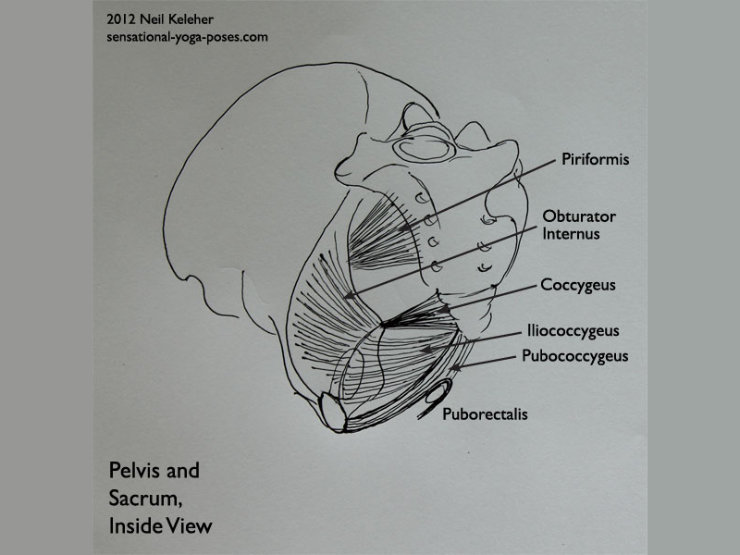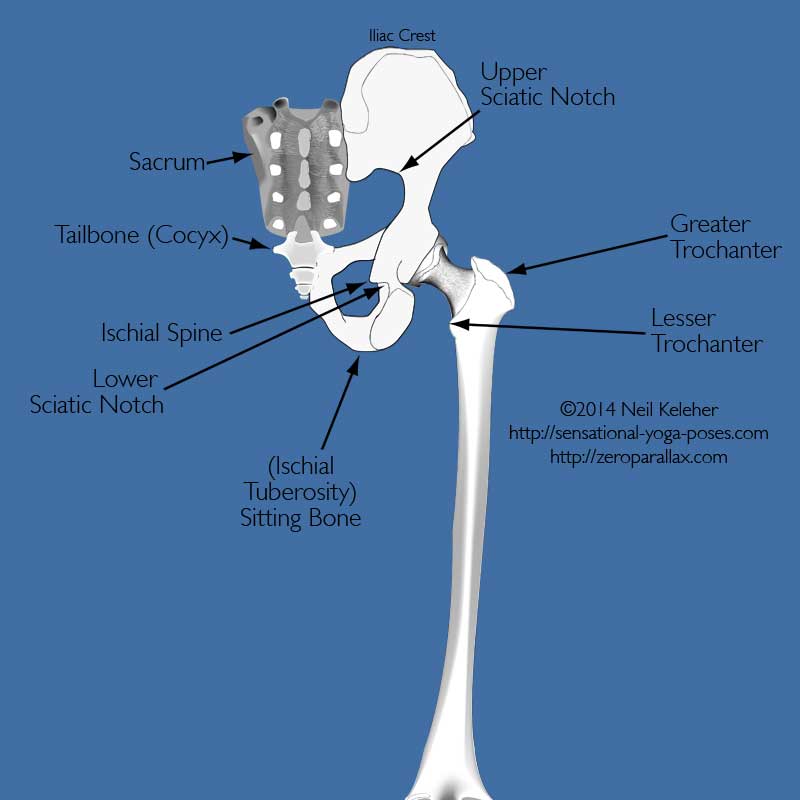What's the Reason for Nutation and Counter Nutation?
A reason given for nutation and counter nutation are that it facilitates child birth.
Another possible explanation and one more useful for those of us interested in improving the function and usability of our bodies is that these action serve a similiar purpose to moving and stabilizing the shoulder blades relative to the ribcage. For example:
- The shoulder blades move to give the arms more reachability.
- They also move so that the arm can clear protuberances. When lifting the arms the shoulder blade rotates upwards (supraversion of the shoulder socket) so that the arm bone clears the roof of bone that covers the shoulder socket, the accromion process.
- The shoulder blades might also be adjusted for different arm positions and actions so that less muscular effort is required to stabilize them relative to the ribcage.
In the case of the pelvis, sacroiliac joint movement may allow hip stability with less muscular effort, and perhaps facilitate hip mobility and flexibility, giving the leg bones more room to move in extreme positions like the splits and back bends and even forward bends.
Counter Nutation SI Joint Exercise
Counter nutation uses the pelvic floor muscles. When I first started learning about it I thought of it as mula bandha, the root lock.
My own mula bandha exercises is based on the anatomy of the pelvic floor and involves first pulling the the bottom tip of the sacrum forwards towards the pubic bone. This should create a line of tension between the tailbone and pubic bone. If it doesn't then practice activating and releasing till you can feel that line of tension.
The next step is to pull inwards on the ischial spines.
These points of bone jut inwards slightly at the back of the pelvis just above the sitting bones.
At about the level of the bottom of the tailbone they separate the upper sciatic notch (where the piriformis passes through the back of the pelvis) and the lower sciatic notch (where the obturator internus wraps around the back of the pelvis.)
When pulling the ischial spines inwards what you are actually looking to create is a line of tension on each side between the tailbone and ischial spines.
I'd suggest this activation sequence:
- pull the tailbone towards the pubic bone,
- then pull the ischial spines inwards.
- Then relax both actions and repeat.
Once you get the general feeling work at creating a smooth and gradual contraction and relaxation versus suddenly turning on and off.
The next step from here in the counter nutation sacroiliac joint exercise is to create a fan of tension. This fan has its handle at the tailbone while the fan shape radiates forwards from the ischial spines to the pubic bone. This fan of tension is an indication that your iliococcygeus muscle is activating.
Again activate smoothly and relax smoothly.
The final two steps in this basic sacroiliac joint exercise is to pull the anus forwards, towards the pubic bone, and then to pull forwards on a point just in front of the anus.
When pulling your tailbone forwards, avoid sucking the sacrum forwards.
Instead focus on creating the above described lines of tension first, then if you like suck the sacrum forwards to activate the piriformis muscle.
Related:
Transverse Abdominis and Sacroiliac Joint Stability
SI Joint Exercises While Sitting or Standing
The above exercises could be done while sitting but I also like to practice them while standing with feet about shoulder width apart, close to parallel with knees slightly bent and torso upright.
Creating a Forward Pull on the Front of the Lower Spine
If you pull your sacrum forwards to activate your piriformis, a further activation you can play with is creating a forwards and downward pull from each side of the lumbar spine to the front of the pelvis on either side of the pubic bone. This is to activate the psoas.
With the pelvic floor muscles activated and with both the sacrum sucking forwards and with a forward pull on the lumbar spine, all the muscles (bar the diaphragm) that connect directly to the front of the spine are active.
To activate the diaphragm, particular where it attaches to the lumbar spine, you could try sucking your lowest back ribs upwards. Failing that focus on drawing the backs of the kidneys upwards.
Counter Nutation SI Joint Exercise and Back Bends
Because this action pulls forwards on the front of the spine it may be handy in back bends, particular poses like wheel pose. In an extreme back bend for the spine your body needs a way to be able to pull out of the pose. Creating tension at the front of the spine may be like a belayer who gradually gives their climbing partner slack so that they can continue to climb upwards while always being ready to add tension if they slip of fall.
Note that I do not suggest holding this contraction. Muscles are designed to contract and relax to allow the body to move. And so focus on both actions so that your body can do both with equal ease.
As for using the mula bandha si joint exercise in yoga poses like wheel pose, or bridge pose. on occasion I also find it helps when I'm trying to jump up into handstand.
SI Joint Exercises for Nutation
One possibility for nutating the sacroiliac joint involves activating the obturator internus and the iliacus, both of which are hip muscles.
Activating the Obturator Internus
The obturator internus, previously mentioned attaches to a large portion of the inner surface of the pelvis. It wraps around the back of the pelvis at the lower sciatic notch and from there attaches to the inner surface of the greater trochanter, near the top.
The piriformis also attaches near here.
In a standing position with the legs stable, the obturator internus can activate and spread the sitting bones. The key is keeping the legs stable, which can be easier to do while standing. The obturator internus tends to try to externally rotate the thighs so to make activating it easier stand with the thighs pointing straight ahead or even slightly internally rotated. And when spreading your sit bones to activate your obturator internus work to prevent your thighs from rotating outwards. Keep them pointing straight ahead.
To accentuate the action you can try activating your iliacus muscle by pulling inwards on the front of the pelvis. If you imagine a line running diagonally from top back to bottom front along the inside of each side of the pelvis, the obturator internus covers the bottom back half of the pelvis, behind and below this line, while the iliacus covers (and attaches to) the upper front half of the pelvis, in front of and above this line. To activate the iliacus try sucking inwards on the ASICs the points at the front of the hip crests. To accentuate the action try also sucking inwards on the triangular portion of each hip bone behind the hip points.
The Lower Transverse Abdominus
For a long while one of the things that bugged me about using the obturator internus and iliacus is that they are hip muscles. I though that there should be a way to create nutation without involving the hips. The most likely candidate is the transverse abdominus. The lower fibers of this muscle attach to the ASICs as well as to the inguinal ligament, which you can recognize as the line that separates each side of your belly from your inner thighs.
Activating these fibers of the transverse abdominus pulls inwards on the front of the pelvis which in turn helps to spread the sitting bones. It also adds tension to the si joint ligaments at the back of the SI joint.
Tellingly the transverse abdominus tends to activate whenever the pelvic floor muscles are activated. Why might this happen?
If you flex your biceps you may notice that your triceps also activates. It activates to keep your elbow stable so that you can keep your biceps flexed. Likewise with the pelvic floor muscles. When you activate them the transverse abdominus activates to stabilize the sacroiliac joints.
Activating the Sacral Multifidus
The sacral multifidus are a set of small muscles that run along the back of the sacrum between it and a portion of fused fascia called the Thoracolumbar Composite. You could think of them as the bottom most extension of the spinal erectors. Activating the transverse abdominus adds tension to the Thoracolumbar composite which in turn could help to provide a foundation for more effective activation of the sacrum multifidus. These muscles can be used to cause nutation at the sacroiliac joint.
To activate these muscles try flicking the bottom tip of your tailbone backwards, away from your pubic bone. You may notice a tightening at the rear of the sacrum. You can try this action without first activating your transverse abdominus. Then try it before or after activating your transverse abdominus.
One possible activation sequence that involves all three layers of the transverse abdominus is to first flick the tailbone rearwards, then activate the lower transverse abdominus, then the middle layer (between the ribcage and the pelvis) and then the upper layer (that attaches to the arch of the ribcage).
Why and When to Practice Sacroiliac Joint Exercises
One reason for learning these exercises is so that you can recognize when, for example your pelvic floor muscles are tight or excessively tight or when they are loose. This could be a sign that you need to exercise them or that something is wrong somewhere else in the body and so you need to look for why these muscles are tight or loose.
In general I would suggest learning the above exercises just to the point that you can do them without having to think about how to do them. You can then use them at will to notice there effect on your yoga poses.
Because of the close relationship between the hips and the sacroiliac joint I would suggest that sacroiliac joint stability often derives from hip joint stability. And so if you have sacroiliac joint problems, as well as learning the above exercises, also take the time to practice stabilizing your hips.
Published: 2020 08 14
Updated: 2020 11 04




